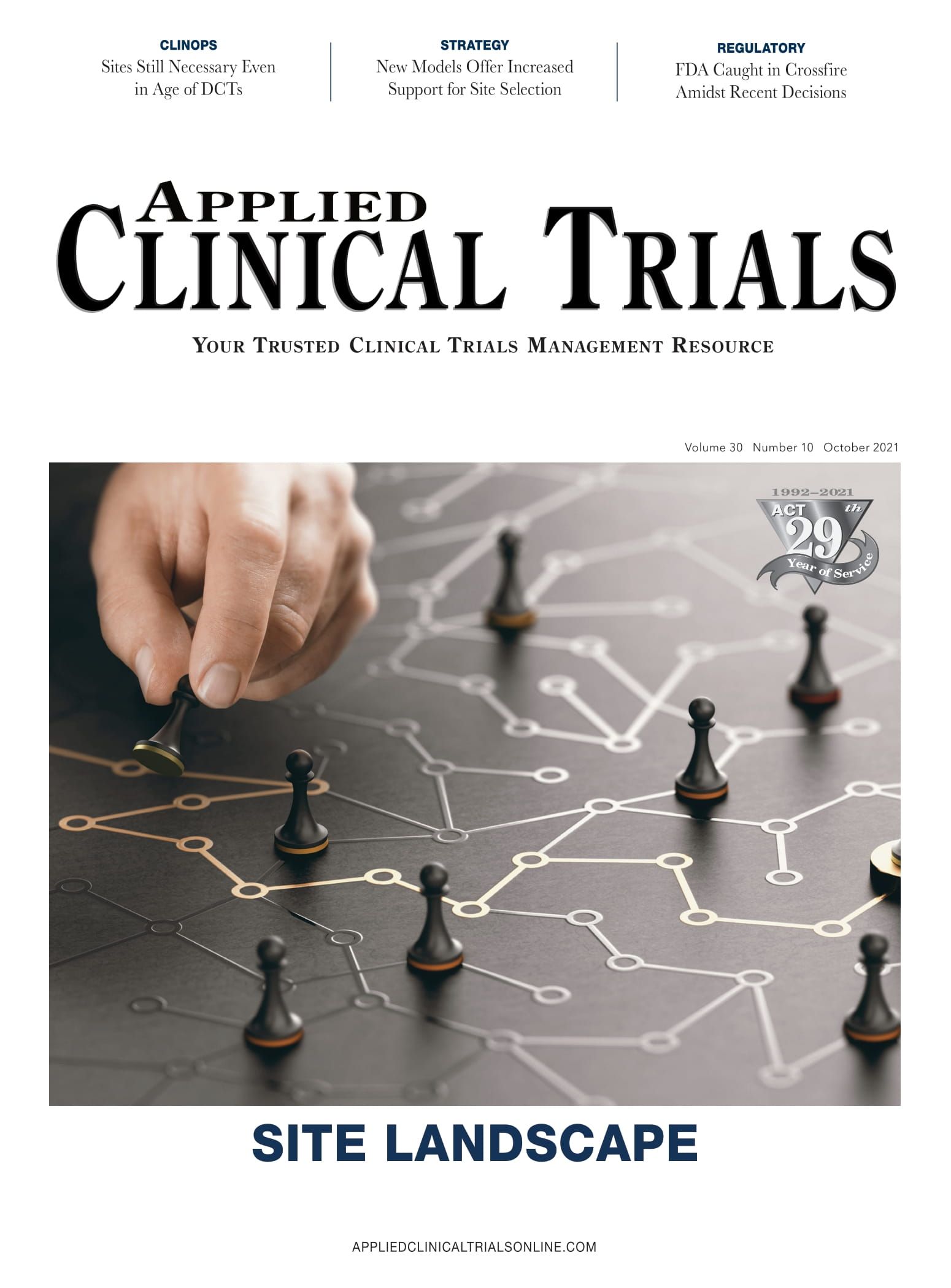Sites Still Necessary for Decentralized Trials
Has technology taken the industry too far?

Today’s headlines in clinical development tout the potential of decentralized trials, with some even going so far as to predict that trials of the future will bypass sites through a combination of centralized review, technology, and just-in-time clinical resources. To the contrary, keeping the site at the center of clinical research, even when taking a decentralized approach, is crucial for success and health outcomes.
Clinical trial designs today span a wide continuum, ranging from 100% site-based trials, where all interactions with study participants occur at the site, to 100% decentralized trials, where all interactions are remote and leverage wearable technologies supplemented by occasional visits by trial nurses to the participants’ homes. The latter are often referred to as “siteless” trials.
However, a large majority are a hybrid of the two. This is true even as decentralization, accelerated by the COVID-19 pandemic, jumped to a 77% CAGR between the second halves of 2019 and 2020, according to data from more than 1,000 trials.1
Despite our extensive involvement in decentralized clinical trials (DCTs), we agree that “siteless” trials are not optimal. The term itself is counterintuitive. The principal investigator’s site, together with trial coordinators, should remain a key part of the trial ecosystem, whether the trial leverages a single site or a network of coordinated sites, local pharmacies, community clinics, and home health aides supported by wearable devices and platform solutions. Technology simply cannot replace people.
Recent industry experience offers a relevant analogy. Between 2005 and 2015, many pharmaceutical companies rapidly adopted salesforce automation tools for their sales representatives while cutting sales jobs at the same time. From its height at 101,000 sales reps in 2005, the number of reps in the US market dipped to 76,000 by 2010 and hit its lowest level of just 66,000 in 2012. Accenture research showed that one in four pharmaceutical sales rep interactions was replaced by digital alternatives, but it did not achieve the intended effect of improved profitability. The strategy backfired and sales dipped. Now, there are more than 100,000 pharma sales reps in the US, according to various estimates, and overall revenues have been setting records year over year. The ship has righted itself.
Today, we are on the doorstep of a similar technology revolution, largely accelerated by COVID-19 when clinical researchers had no choice but to leverage innovative digital technologies to continue their work. Now, the excitement around technology’s potential is soaring again. The innovative technologies enabling remote or decentralized trials have the potential to dramatically reduce the burden for patient participation in research and for sites who manage studies. Recent data backs this claim, with at least half of the respondents to a recent Association of Clinical Research Professionals’ (ACRP) survey anticipate ‘strong’ use of eConsent (63%), eSource (56%), remote monitoring (55%), and wearables (50%) post pandemic.2 Decentralized trials are here to stay.
Caution: Watch what you say
Industrywide, there is confusion over terms like “virtual,” “remote,” and “siteless” trials; hybrid trials; and even the DCT concept itself. On the one hand, the Society for Clinical Research Sites (SCRS), in a December 2020 white paper defined its subject thus: “For the purposes of this survey, ‘decentralized or virtual’ referred to studies that are fully virtual, meaning that all study visits are remote.”3 On the other hand, even a cursory review of current literature on DCTs will demonstrate phrases like “decentralized or hybrid,” blurring the distinction between trials with or without patient site visits.
The DCT concept traces back to the 2018 Clinical Trials Transformation Initiative (CTTI) white paper that specifies that “DCTs can be conducted as 100% decentralized or as a hybrid study in which the DCT offers the additional flexibility of incorporating both in-person visits and virtual visits into the study as appropriate.”4 Although the intent, was to standardize terminologies, this definition proposes that “decentralized” and “hybrid” are synonymous.
There is also some evidence of the impact of the COVID-19 pandemic changing perspectives on “siteless” or fully virtual trials, and hybrid DCTs. A July 2020 SCRS survey found that a mere 3% of clinicians “had participated in a completely virtual trial, where all visits are conducted remotely.”5 But the December 2020 SCRS white paper, based on a May-to-July survey, found that use of “the fully virtual approach” had risen to 15.46%. More recent data found that 22% of respondents conducted “siteless” trials pre-pandemic; 17% had done so during the pandemic “but not because of it,” and an additional 12% had done so “because of COVID-19.”6
The clinical trial lexicon will continue to evolve, but “siteless” should not receive a dictionary reference.
The future is not all or nothing

Rather than a “siteless” trial, the better approach is to build fit-for-purpose clinical research with a next-generation site at its center. Some trials might be, in fact, wholly decentralized, but even those should incorporate a site whose role may be a different iteration of what a traditional site looks like today. The best-performing trials will continue to have human interactions between physicians and patients. They will not be without sites but, rather, be technology-enabled to reduce burdens and improve efficiency. That is what well-designed technology should do, for both patients and for trial administrators.
Among other benefits, DCTs promise to 1) improve the recruitment and retention of trial participants and 2) increase diversity in trial populations. Given that only seven of 100 enrolled patients complete trials7, ensuring patient retention through all means is vital to trial execution and research efficiency. Interactions with trial physicians, care coordinators, and operational staff are vital to these goals.
People are foundational to clinical research, and the physician/patient relationship is the building block for long-term participation in a trial. It also builds trust, something that is especially critical today as public confidence among minority communities has eroded dramatically since the start of the pandemic. Patients develop close relationships with their study coordinators, who spend time engaging on a very personal level and deliver tender care. Coordinators and site staff give hugs, call patients by their first names, and nurture the relationship. In fact, this is the number one determinant of a patient’s completion of a trial. A “siteless” experience takes this away.
DCT technology should assist site administrators in fostering a trusted patient relationship, while at the same time provide improvements in data quality, data collection, study startup speed, informed consent, regulatory compliance, and all the other goals of a well-run trial. In the aforementioned 2021 Avoca survey, respondents report the two most substantial benefits of DCT technologies are: retention of study participants (with a mean score of 4.2 on a 1-5 scale); and diversity of study participants (3.9). Technology along with real-life patient engagement are the one-two punch to overcoming two of our greatest trial obstacles.
Besides the obvious obstacle to better patient recruitment and retention of travel to and from trial sites, patients can also suffer from limitations in handling modern technologies, ranging from lack of familiarity with smartphones to poor WiFi connections in their homes. In these cases, site-driven, hands-on guidance is paramount to the success of a DCT–and is another instance where the personal touch provided by a trial site is important.
Another aspect of patient retention in clinical trials is the health of the patients themselves. Rochester Clinical has had direct experience with assisting trial participants in getting necessary (in some cases, lifesaving) medical attention to patients that was unrelated to the trial itself. Some of this diagnosis was captured in the initial intake of the patient, where gentle probing helped get closer to the root of illness or personal insights on the patient’s health. In other cases, trial managers uncovered new health problems that cropped up during the trial because of close monitoring. Maybe some of these cases would have been recognized even with a “siteless” trial leveraging wearable technology; maybe not.
The role of sites will evolve, not fade
While technology can make the process of getting patients signed up for a trial easier, thanks to eSource, eConsent, and remote monitoring tools, there’s a misconception that it reduces the need for a site and its people. On the contrary, these new technologies open the door for new expertise, including more technology support but do not change the fact that there needs to be a centralized location for research and the back-end aspects of a well-executed trial.
The life sciences industry is having the wrong conversation about DCTs. Rather than talking about how DCT technology can replace sites, the conversation should shift to how to better support sites with technology. Technology companies and site managers should not be at odds with each other. Instead, they should be collaborators in providing the best patient experience and enabling successful trials.
References
- Applied Clinical Trials, “Why Decentralized Trials are the Way of the Future,” by Fan Gao, Maurice Solomon, Arnab Roy, and William Chaplain (April 5, 2021).
- Association of Clinical Research Professionals, Clinical Researcher, “Delving into eConsent: An Industry Survey,” (January 14, 2020) by Neetu Pundir; Mika Lindroos; Jenna McDonnell; Bill Byrom; Spencer Egan.
- “Patient Centricity and Virtualizing Technologies in a COVID-19 World.”
- Clinical Trials Transformation Initiative (CTTI), “CTTI Recommendations: Decentralized Clinical Trials (September 2018).
- Society of Clinical Research Sites, “Impact Assessment of Decentralized Clinical Trials (DCT) Awareness in the Clinical Research Industry,” (2018).
- WCG Avoca Group, “2020 State of the Industry Report” (June 2021).
- Advarra Report, “Retention in Clinical Trials: Keeping Patients on Protocols,” (March 23, 2021).
Mary Costello, Head of Sites for Medable and Pat Larrabee, CEO of Rochester Clinical Research

Improving Relationships and Diversifying the Site Selection Process
April 17th 2025In this episode of the Applied Clinical Trials Podcast, Liz Beatty, co-founder and chief strategy officer, Inato, discusses a number of topics around site engagement including community-based sites, the role of technology in improving site/sponsor relationships, how increased operational costs are impacting the industry, and more.
SCOPE Summit 2025: Enhancing the Patient Experience Through Site Centricity
February 12th 2025In an interview with ACT senior editor Andy Studna at SCOPE Summit, Ashley Davidson, vice president, product lead - sponsor tech strategy, Advarra, highlights the need for more site-centric approaches in study startup.